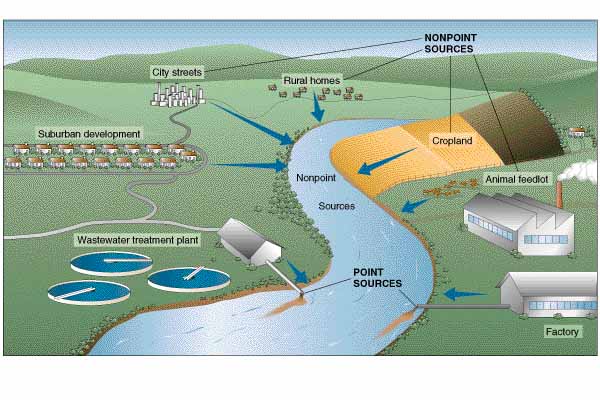11 Which of the Following Is Considered Point Source Pollution
I think the correct answer from the choices listed above is the first option. Score 1jtj_helloPoints 565 User.

Awareness Campaign Against Water Pollution Awareness Campaign Water Pollution Pollution
Environmental Protection Agency EPA defines point source pollution as any single identifiable source of pollution from which pollutants are discharged such as a pipe ditch ship or factory smokestack Factories and sewage treatment plants are two common types of point sources.

. View Notes - ABS 270 Week 11 from ABS 270 at Arizona State University. One new form of water pollution is caused by the use of human - made materials such as __ _ Plastics___ which make up millions of products all of which eventually end up in the environment 27. Which of the following is considered point source pollution.
An animal feedlot b. Worldwide __ Diarrhea_ caused mostly by exposure to polluted water on average kills a young child every 18 seconds. Question 2 options.
Based on Figure 1111 water availability per person per year is lowest in these two countries Africa and Asia All of the following are example of point source pollution except _________________. Which of the following would most likely be considered point source pollution. Examples include smokestacks discharge pipes and.
A fertilizer runoff from lawns. Animal waste from a local horse farm seeping into the ground would most likely be considered nonpoint source pollution. Chapter 22 - Water Pollution.
Sewer water rinsed off the freeway. Nonpoint source pollution generally happens as a result of many systems interacting and is not directly attributed to one event or pollutant. Which of the following would not be considered a point source pollution contributora.
A paper mill d. Examples include smokestacks discharge pipes and drainage ditches. Non-point sources include water coming from fields as runoff roads and streets directly goes to river bodies polluting the water and degrade its quality.
Learn vocabulary terms and more with flashcards games and other study tools. Cattle on rangeland c. Environmental Protection Agency EPA defines point source pollution as any single identifiable source of pollution from which pollutants are discharged such as a pipe ditch ship or factory smokestack Factories and sewage treatment plants.
C road salt from highways. The United States Environmental Protection Agency EPA defines point source pollution as any contaminant that enters the environment from an easily identified and confined placeNonpoint-source pollution is the opposite of point-source pollution with pollutants released in a wide area. Factories and power plants can be a source of point-source pollution affecting both air and water.
This type of pollution is caused by rainfall or. A paper mill d. The United States Environmental Protection Agency EPA defines point source pollution as any contaminant that enters the environment from an easily identified and confined place.
A gas leak from an underground tank. Which of the following would not be considered a point source pollution contributora. Which of the following is not considered a pollutant in the marine environment.
All of the above. Generally natural environmental systems participate in pollution of this kind regardless of whether or not human activity was a factor. B pesticide runoff from agricultural fields.
Septic tank one meter from a shallow well. Runoff from an agricultural community. An important indicator of water quality is the.
A paper mill would not be considered a point source pollution contributor. It is pollution that comes from many places all at once. Examples include water runoff or erosion.
Cattle on rangeland c. Which of the following would be a point source of pollution. A paper mill would not be considered a point source pollution contributor.
Nonpoint-source pollution is harder to identify and harder to address. Matter is moved through the Earth by the interaction of Earths. Nonpoint-source pollution is the opposite of point-source pollution with pollutants released in a wide area.
None of the above. The term nonpoint source is defined to mean any source of water pollution that does not meet the legal definition of point source in section 502 14 of the Clean Water Act. Start studying Oceanography -Chapter 11- Marine Pollution.
Score 1mangioonPoints 191 User. Which of the following would most likely be considered nonpoint source pollution. D all of the above.
Question 2 05 points Match the examples of water pollution below to the correct type of pollutant. Which of the following would be considered a non-point source pollution. The term point source means any discernible confined and discrete conveyance including but not limited to any pipe ditch channel tunnel.
Non-point sources of pollution are often termed diffuse pollution and refer to those inputs and impacts which occur over a wide area and are not easily attributed to a single source. Group of answer choices. Yellowstone National Park has an average of about 4500 bison living in it.
An animal feedlot b. Which of the following is considered a non-point source of water pollution. Which of the following most likely comes from nonpoint source pollution.

Environment Management In Oil Refineries Refinery Oil Refinery Environment

Pin By Polar Bear On Nature Ocean Currents Map Ocean Pollution Global Warming Climate Change

What Is The Difference Between Point Source And Nonpoint Source Water Pollution Socratic
No comments for "11 Which of the Following Is Considered Point Source Pollution"
Post a Comment